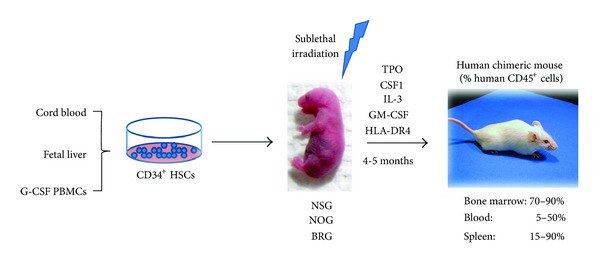Figure 1.

Generation of “humanized” mice. The reconstitution of the hematolymphoid compartment in immunocompromised mice is carried out by human CD34+ HSCs. Human HSCs can be isolated from umbilical cord blood (CB), fetal liver, or adult peripheral blood mononuclear cells (PBMCs) after mobilization of bone marrow HSCs by granulocyte-colony stimulating factor (G-CSF) injections. Although sublethally irradiated newborn NSG, NOG, or BRG immunocompromised mice are the most permissive recipients for engraftment of human CD34+ HSCs, exogenous supply of human cytokines or HLA class II transgenes creates a better environment for cell engraftment and improved development and function of the resultant differentiated immune cell lineages. Abbreviations used: BRG: BALB/c Rag2−/− Il2rγ −/−, CSF1: colony stimulating factor 1, GM-CSF: granulocyte-monocyte colony stimulating factor, HSCs: hematopoietic stem cells, IL-3: interleukin-3, NOG: NODShi-SCID Il2rγ −/−, NSG: NODLtSz-SCID Il2rγ null/null, TPO: thrombopoietin.
